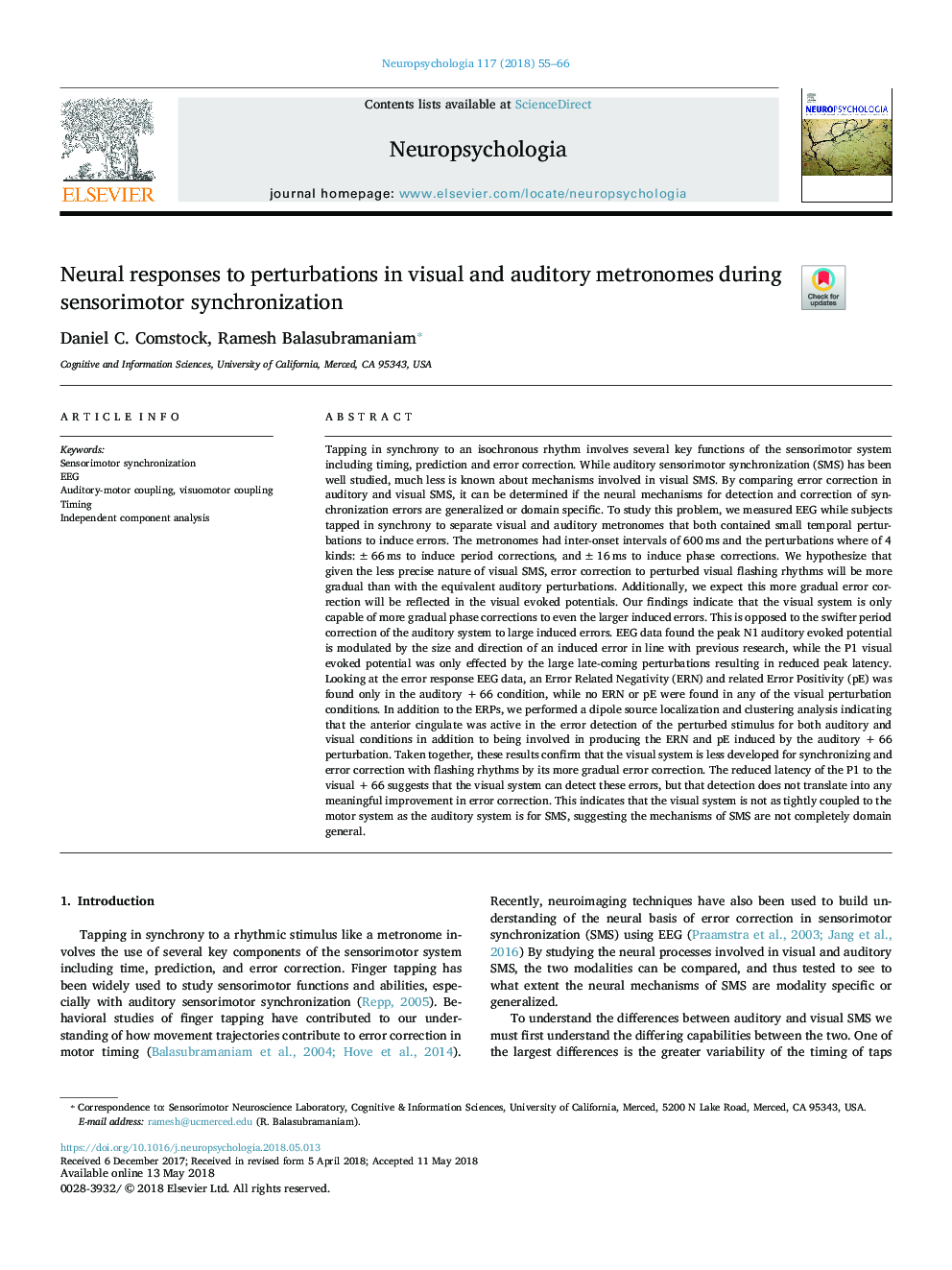| کد مقاله | کد نشریه | سال انتشار | مقاله انگلیسی | نسخه تمام متن |
|---|---|---|---|---|
| 7317173 | 1475538 | 2018 | 12 صفحه PDF | دانلود رایگان |
عنوان انگلیسی مقاله ISI
Neural responses to perturbations in visual and auditory metronomes during sensorimotor synchronization
ترجمه فارسی عنوان
پاسخ های عصبی به اختلالات در مترونوم های بصری و شنوایی در زمان هماهنگ سازی سنسور حرکتی
دانلود مقاله + سفارش ترجمه
دانلود مقاله ISI انگلیسی
رایگان برای ایرانیان
کلمات کلیدی
موضوعات مرتبط
علوم زیستی و بیوفناوری
علم عصب شناسی
علوم اعصاب رفتاری
چکیده انگلیسی
Tapping in synchrony to an isochronous rhythm involves several key functions of the sensorimotor system including timing, prediction and error correction. While auditory sensorimotor synchronization (SMS) has been well studied, much less is known about mechanisms involved in visual SMS. By comparing error correction in auditory and visual SMS, it can be determined if the neural mechanisms for detection and correction of synchronization errors are generalized or domain specific. To study this problem, we measured EEG while subjects tapped in synchrony to separate visual and auditory metronomes that both contained small temporal perturbations to induce errors. The metronomes had inter-onset intervals of 600â¯ms and the perturbations where of 4 kinds: ± 66â¯ms to induce period corrections, and ± 16â¯ms to induce phase corrections. We hypothesize that given the less precise nature of visual SMS, error correction to perturbed visual flashing rhythms will be more gradual than with the equivalent auditory perturbations. Additionally, we expect this more gradual error correction will be reflected in the visual evoked potentials. Our findings indicate that the visual system is only capable of more gradual phase corrections to even the larger induced errors. This is opposed to the swifter period correction of the auditory system to large induced errors. EEG data found the peak N1 auditory evoked potential is modulated by the size and direction of an induced error in line with previous research, while the P1 visual evoked potential was only effected by the large late-coming perturbations resulting in reduced peak latency. Looking at the error response EEG data, an Error Related Negativity (ERN) and related Error Positivity (pE) was found only in the auditory +â¯66 condition, while no ERN or pE were found in any of the visual perturbation conditions. In addition to the ERPs, we performed a dipole source localization and clustering analysis indicating that the anterior cingulate was active in the error detection of the perturbed stimulus for both auditory and visual conditions in addition to being involved in producing the ERN and pE induced by the auditory +â¯66 perturbation. Taken together, these results confirm that the visual system is less developed for synchronizing and error correction with flashing rhythms by its more gradual error correction. The reduced latency of the P1 to the visual +â¯66 suggests that the visual system can detect these errors, but that detection does not translate into any meaningful improvement in error correction. This indicates that the visual system is not as tightly coupled to the motor system as the auditory system is for SMS, suggesting the mechanisms of SMS are not completely domain general.
ناشر
Database: Elsevier - ScienceDirect (ساینس دایرکت)
Journal: Neuropsychologia - Volume 117, August 2018, Pages 55-66
Journal: Neuropsychologia - Volume 117, August 2018, Pages 55-66
نویسندگان
Daniel C. Comstock, Ramesh Balasubramaniam,
